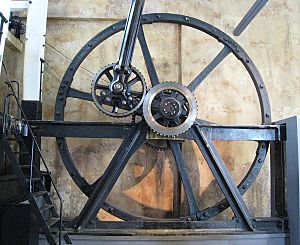Sun and planet gear facts for kids

The sun and planet gear is a clever mechanical system. It changes a back-and-forth (up-and-down) movement into a spinning (circular) movement. This invention was very important for early steam engines. It helped them power machines that needed a rotating motion.
This special gear was invented by a Scottish engineer named William Murdoch. He worked for a famous company called Boulton and Watt. However, James Watt patented the idea in 1781. He did this to get around another patent. Someone else already owned the patent for the simple crank system. The sun and planet gear was a big step forward during the Industrial Revolution. It helped create many new spinning machines.
How the Sun and Planet Gear Works

Imagine a steam engine's arm moving up and down. The sun and planet gear takes this up-and-down motion and turns it into a steady spin. Here's how it works:
- A "planet" gear is attached to the end of the engine's connecting rod. This rod moves with the engine's arm.
- As the rod moves, the planet gear travels around a central "sun" gear.
- The sun gear is fixed to a drive shaft. When the planet gear moves around it, it makes the sun gear spin. This spinning motion is then used to power other machines.
One cool thing about this system is its speed. If the sun and planet gears have the same number of teeth, the drive shaft spins twice for every up-and-down cycle of the engine's arm. A simple crank would only spin once. The planet gear itself does not spin on its own axis; it just orbits the sun gear.
There's also a link that connects the axles of the two gears. This link helps keep the gears meshed together. It doesn't help with the power transfer, though. This design was important because it didn't break the patent on the simple crank.
See also
- Epicyclic gearing

